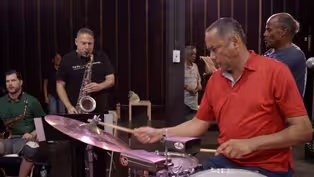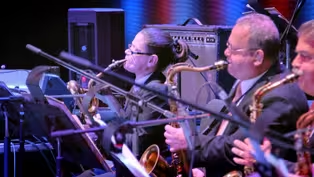
Introducing the Mambo Legends Orchestra
Clip: Season 2024 Episode 3 | 6m 45sVideo has Closed Captions
Meet the Mambo Legends Orchestra, comprised of former members of the Tito Puente Orchestra.
Meet the Mambo Legends Orchestra who committed to keeping the sounds of the great Afro-Cuban bandleaders Machito, Tito Puente, and Tito Rodriguez alive for future generations.
Problems playing video? | Closed Captioning Feedback
Problems playing video? | Closed Captioning Feedback

Introducing the Mambo Legends Orchestra
Clip: Season 2024 Episode 3 | 6m 45sVideo has Closed Captions
Meet the Mambo Legends Orchestra who committed to keeping the sounds of the great Afro-Cuban bandleaders Machito, Tito Puente, and Tito Rodriguez alive for future generations.
Problems playing video? | Closed Captioning Feedback
How to Watch VOCES
VOCES is available to stream on pbs.org and the free PBS App, available on iPhone, Apple TV, Android TV, Android smartphones, Amazon Fire TV, Amazon Fire Tablet, Roku, Samsung Smart TV, and Vizio.
Buy Now
Providing Support for PBS.org
Learn Moreabout PBS online sponsorship(overlapping chatter) (instruments warming up) (instruments warming up) JOSE: Okay, let's play "Dance Mania" now.
"Dance Mania".
Now listen, if you know, have a solo in this number, please come up to where the solo mic is, or you're not going to have very much time to play because we have 55 minutes, so everything is going to be pretty short.
I hope everybody heard what the [deleted] I said.
One, two, three.
(mambo music playing).
♪ ♪ ♪ ♪ ♪ Hey!
(mambo music playing).
♪ Here we go!
One, two... (mambo music playing).
Uh!
Here we go!
One, two... (mambo music playing).
♪ ♪ ♪ ♪ One!
(song ends).
Sonny, what's wrong with you?
Come on.
SONNY: Wait a minute.
I got to take my med's.
(laughter).
(overlapping chatter).
MEMBER: Hurry up, after this, your ride is waiting... JOSE: Don't worry, we'll laugh tomorrow when you get paid.
Here we go.
I was born in New York City a long time ago.
My dad was born in Guayama, Puerto Rico.
He's part of the Madera family in Puerto Rico.
And my dad came to New York in 1929 and immediately started playing saxophone.
He played in the theaters, in the shows, and at Teatro Hispano, he played with Nobles Sissle's jazz band.
He played with Alberto Iznaga, he played with Agusto Coen.
And then, in 1939, Machito came along, and they started the Machito Band.
♪ MACHITO: Nague, nague, nague... ♪ ♪ Nague, nague, nague.
JOE: The Afro-Cuban movement started from the mother country, which was Africa, migrated to New Orleans and to Cuba, and the father of that music was basically Machito.
JOSE: Because of the segregation issues in New York and the country those years.
Machito Band was really the first band to play south of 96th Street, a lot of Blacks and Hispanics in that band.
So you could actually say that maybe they were the first ones that really started playing that style of music.
And from there, it obviously went on.
You have Tito Puente, you have Tito Rodriguez much later.
You have a ton of orchestras that come up, but I'd have to say that of all those bands, the foremost exponent of that music was Machito.
And the first lady of song here is Graciela.
♪ GRACIELA: ¡Ay José!
♪ Así no es.
♪ ¡Ay José!
♪ Que rico es.
JOE: She came here in 1943 because her brother Machito was drafted, and Mario Bauzá, who was the musical director who was Machito's brother-in-law, he sent for Graciela, who was singing with one of the first all-female bands in Cuba, which was called Anacaona.
JOSE: I think she is the epitome of all of this because she could sing Bolero, she could sing cha cha, and she could sing fast, and she could sing American.
♪ GRACIELA: José asi!
Behind the Scenes with the Band
Video has Closed Captions
Clip: S2024 Ep3 | 6m 57s | Go behind the scenes with the Mambo Legends Orchestra. (6m 57s)
Video has Closed Captions
Clip: S2024 Ep3 | 12m 17s | Meet the members of the Mambo Legends Orchestra. (12m 17s)
Providing Support for PBS.org
Learn Moreabout PBS online sponsorshipSupport for PBS provided by:

















